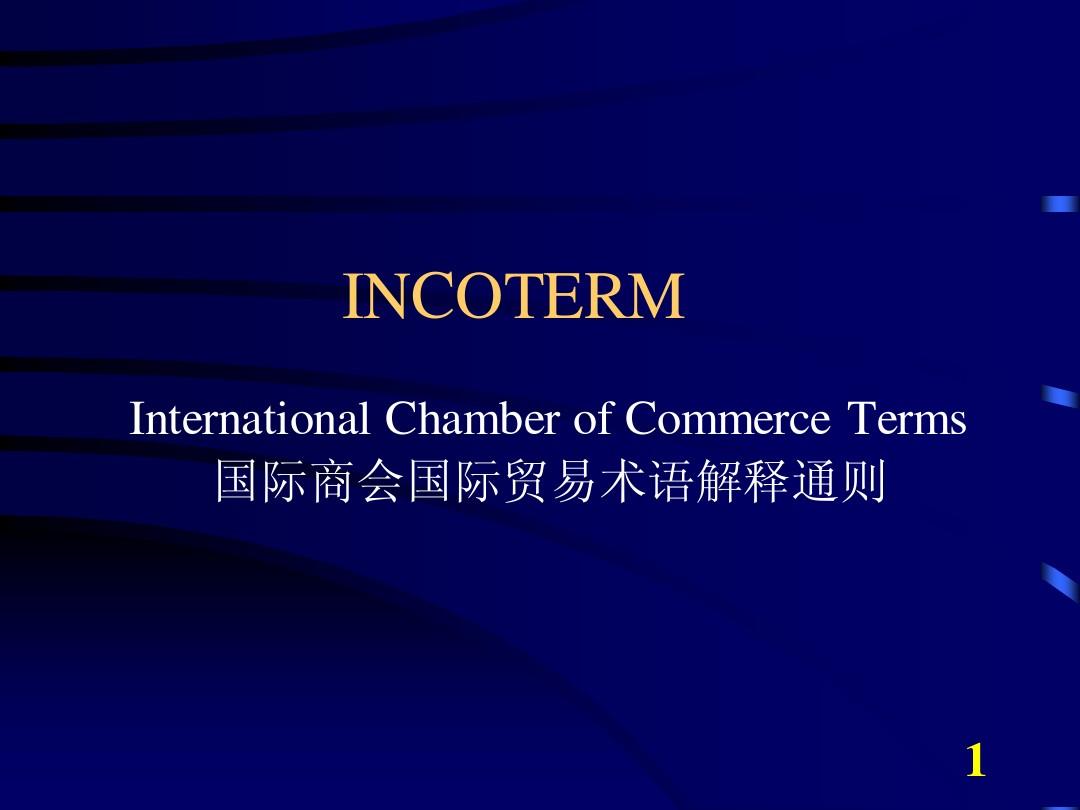国际贸易中常见的货运方式及英文表达(I)
1. 成本加运费(CFR或C&F== Code of Federal Regulations; cost and freight )
成本加运费,英文为" Cost and Freight (named port of shipment)", 即"成本加运费(……指定目的港)"。
中文释义:
成本加运费(Cost and Freight)指在装运港船上交货,卖方需支付将货物运至指定目的地港所需的费用。但货物的风险是在装运港船上交货时转移。按CFR条件成交时,由卖方安排运输,由买方办理货运保险。如卖方不及时发出装船通知,则买方就无法及时办理货运保险,甚至有可能出现漏保货运险的情况。本术语适用于海运或内河运输。
英文释义:
Cost and freight (CFR) is a legal term used in foreign trade contracts. In a contract specifying that a sale is cost and freight, the seller is required to arrange for the carriage of goods by sea to a port of destination and provide the buyer with the documents necessary to obtain them from the carrier.
With a cost and freight sale, the seller is not responsible for procuring marine insurance against the risk of loss or damage to the cargo during transit. Cost and freight is a term used strictly for cargo transported by sea or inland waterways.
Cost and freight used to be abbreviated as C&F. Then, in 1990, it was changed to CFR by Incoterms, a set of commercial trade rules established by the International Chamber of Commerce (ICC), after users complained of difficulties adding the ampersand symbol in telex messages and other technology used in the 1970s and 1980s.
2. 成本、保险费加运费(CIF)
成本、保险费加运费,英文为"Cost,Insurance and Freight(…named port of shipment)", 即"成本、保险费加运费(……指定目的港)"。
中文释义:
成本、保险费加运费,货价的构成因素中包括从装运港至约定目的地港的通常运费和约定的保险费,故卖方除具有与CFR术语的相同的义务外,还要为买方办理货运保险,支付保险费,按一般国际贸易惯例,卖方投保的保险金额应按CIF价加成10%。如买卖双方未约定具体险别,则卖方只需取得最低限度的保险险别,如买方要求加保战争保险,在保险费由买方负担的前提下,卖方应予加保,卖方投保时,如能办到,必须以合同货币投保。
英文释义:
Cost, insurance, and freight (CIF) is an international shipping agreement, which represents the charges paid by a seller to cover the costs, insurance, and freight of a buyer's order while the cargo is in transit. Cost, insurance, and freight only applies to goods transported via a waterway, sea, or ocean.
The goods are exported to the buyer's port named in the sales contract. Until the goods are delivered to the buyer's destination port, the seller bears the costs of any loss or damage to the product. Further, if the product requires additional customs duties, export paperwork, or inspections or rerouting, the seller must cover these expenses.
However, once the goods have reached the buyer's port of destination, the buyer assumes responsibility for any fees or charges for unloading and delivering the shipment to the final destination. CIF is similar to carriage and insurance paid to (CIP), but CIF is used for only sea and waterway shipments, while CIP can be used for any mode of transport, such as by truck.
PS:CIF术语要求卖方办理货物出口报关手续,买方办理货物进口清关手续。该术语仅适用于海运和内河运输。
3. 运费及保险费付至(CIP=Carriage and Insurance Paid to)
运费及保险费付至,英文为"Carriage and Insurance Paid to(… named place of destination)", 即"运费及保险费付至(……指定目的地)。"
中文释义:
运费及保险费付至指卖方除负有与运费付至(……指定目的地)术语相同的义务外, 卖方还须办理货物在运输途中应由买方承担的货物灭失或损坏风险的海运保险并支付保险费。 本术语适用于任何运输方式。
英文释义:
Insurance is a long-standing practice in trading, and carriage and insurance paid to (CIP) is when a seller pays freight and insurance to deliver goods to a seller-appointed party at an agreed-upon location. The risk of damage or loss to the goods being transported transfers from the seller to the buyer as soon as the goods are delivered to the carrier or appointed person.
CIP is comparable to but different from cost, insurance, and freight (CIF), an agreement that is used in maritime trade and commodity trading. Under CIP, the seller is obligated to insure goods in transit for 110% of the contract value. If the buyer desires additional insurance, they must arrange for it on their own.
CIP is one of 11 Incoterms, a series of globally accepted commercial trade terms most recently published in 2020 by the International Chamber of Commerce (ICC).
4. 运费付至(CPT=Carriage Paid to)
运费付至,英文为"Carriage Paid to):tid to(… named place of destination)", 即"运费付至(……指定目的地)"。
中文释义:
运费付至,根据国际商会最新颁布的《1990年国际贸易术语解释通则》,“运费付至” 系指卖方支付货物运至指定目的地的运费。关于货物损失或损坏的风险以及自货物交至承运人后发生事件所产生的任何额外费用,自货物已交付至承运人照管之时起,从卖方转由买方承担。
“承运人”系指在运输合同中,通过铁路、公路、海运、空运、内河运输或这些方式之联合运输,承担履行运输或承担办理运输业务的人。如果由后继承运人将货物运至约定的目的地,风险自货物交付第一承运人时起转移。 CPT术语要求卖方办理货物进口的结关手续。本术语可适用于各种运输方式,包括多式联运。
英文释义:
Carriage Paid To (CPT) is an international trade term that means the seller delivers the goods at their expense to a carrier or another person nominated by the seller. The seller assumes all risks, including loss, until the goods are in the care of the nominated party.
The carrier could be the person or entity responsible for the carriage (by sea, rail, road, etc.) of the goods or the person or entity enlisted to procure the performance of the carriage. The CPT price might include Terminal Handling Charges (THC) in their freight rates.
5. 边境交货(DAF=Delivered at Frontier)
边境交货,英文为"Delivered at Frontier(…named place)", 即"边境交货(……指定地点)"。
中文释义:
边境交货(指定地点)是指当卖方在边境的指定的地点和具体交货点,在毗邻国家海关边界前,将仍处于交货的运输工具上尚未卸下的货物交给买方处置,办妥货物出口清关手续但尚未办理进口清关手续时,即完成交货。
英文释义:
"Delivered at frontier" (DAF) is a term used in international shipping contracts that requires a seller to deliver goods to a border location. The seller is usually responsible for all costs of transporting the goods to the drop-off point for the buyer. The party picking up the goods will usually be importing them and traveling across customs.
6. 目的港船上交货(DES=Delivered Ex Ship)
目的港船上交货,英文为"Delivered Ex Ship(… named port of destination)", 即"目的港船上交货(……指定目的港)"。
中文释义:
目的港船上交货指卖方负责租订运输工具,在规定的时间内将已清关货物运抵指定的目的港,在目的港船上交货并承担交货前的费用、风险的贸易术语。DES不同于象征性交货的CIF,它是实际交货,因此,卖方是为自己的利益办理运输和保险事宜。
英文释义:
Delivered ex-ship (DES) was a trade term that required a seller to deliver goods to a buyer at an agreed port of arrival. The seller assumed the full cost and risk involved in getting the goods to that point. After arrival, the seller was considered to have met its obligation and the buyer assumed all ensuing costs and risks.
This term applied to both inland and sea shipping and often in charter shipping. It expired effective 2011.
参考:
百度百科
Investopedia



